1.6: Social Change and Resistance
- Last updated
- Save as PDF
- Page ID
- 199213

- Erika Gutierrez, Janét Hund, Shaheen Johnson, Carlos Ramos, Lisette Rodriguez, & Joy Tsuhako
- Long Beach City College, Cerritos College, & Saddleback College via ASCCC Open Educational Resources Initiative (OERI)
Social change refers to the transformation of culture, behavior, social institutions, and social structure over time. Social change has impacted race and ethnic relations over the course of U.S. history, often in the form of pendulum swings or simultaneous, competing social changes.
Sources of Social Change
There are many sources of social change which include: modernization; population growth and composition; culture and technology; natural environment; social institutions; and social movements. These sources of social change impact the climate of race and ethnic relations in the United States.
Modernization and Urbanization
As societies become more modern, they become larger and more heterogeneous. Traditional ways of thinking decline, and individual freedom and autonomy increase. Modernization refers to the process of increased differentiation and specialization within a society, particularly around its industry and infrastructure. Modernization increases as populations move from rural to urban spaces leading to urbanization, the rise and growth of cities. Urban residents tend to be more tolerant than rural residents of nontraditional attitudes, behaviors, cultures, and lifestyles. Immigrants from more traditional societies who move into urban settings also experience this modernization and urbanization which in turn has a ripple effect on family dynamics and one's home country.
Population Growth and Composition
Three of the factors that determine population growth are fertility, mortality, and net migration. Over the next four decades, as fertility rates are projected to continue to fall and modest increases are projected for the overall level of net international migration, the U.S. population is projected to continue to grow. While the current U.S. population is more than 330 million, the population of the U.S. is projected to exceed 400 million before 2050, as shown in Figure 1.6.1. In 2019, millennials,
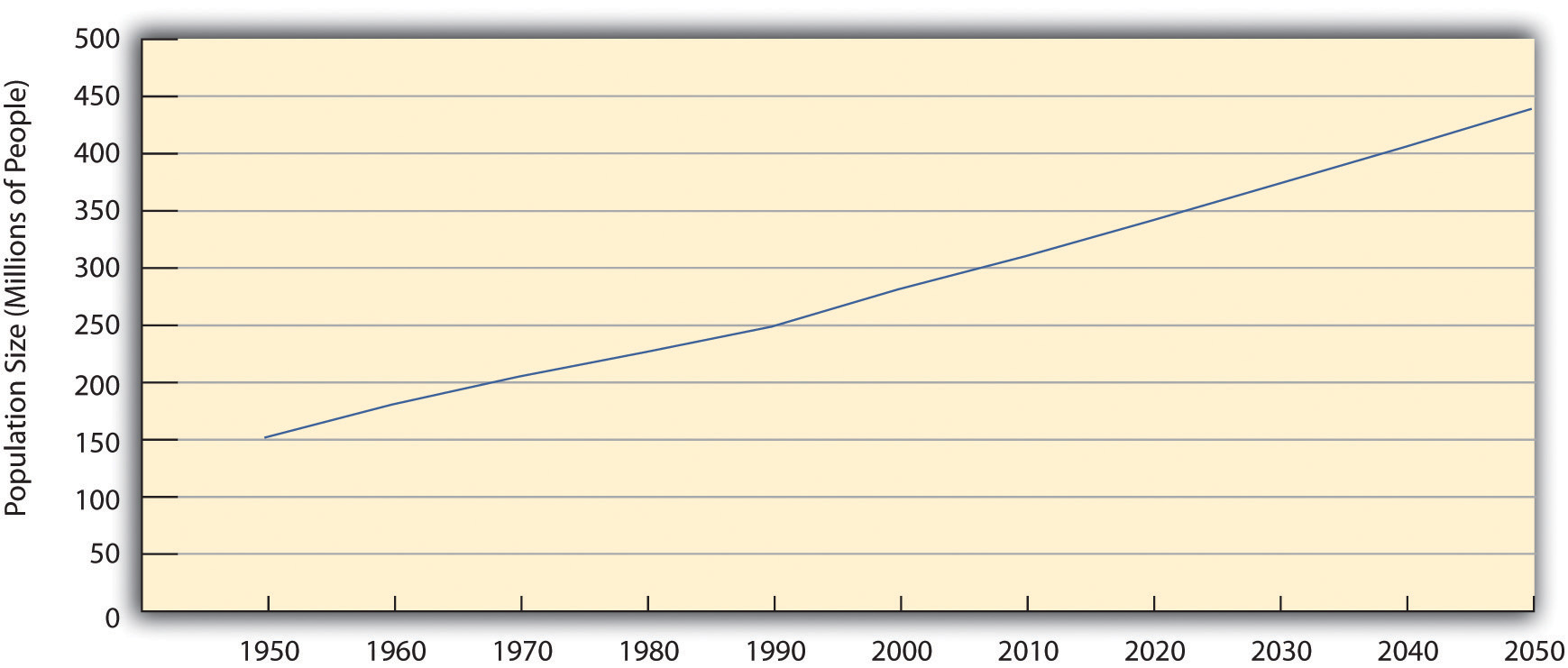
those ages 23 to 38, outnumbered Baby Boomers (ages 55 to 73), according to the U.S. Census. Millennials are more educated, more racially and ethnically diverse, slower to marry than previous generations were at the same age, and are putting off childbirth. The immigrant share of the U.S. population is nearing an all-time high percentage of the U.S. population, at 13.6% of the U.S. population in 2017. However, the numbers of undocumented immigrants have been decreasing over the past decade.
As the final chapter in this book, Chapter 12.4, further explains, the United States is projected to become more racially and ethnically diverse in the coming years, thus a majority people of color nation, or a plurality nation. As shown in Figure 1.6.2, among those under 18, the U.S. is already a majority people of color country.
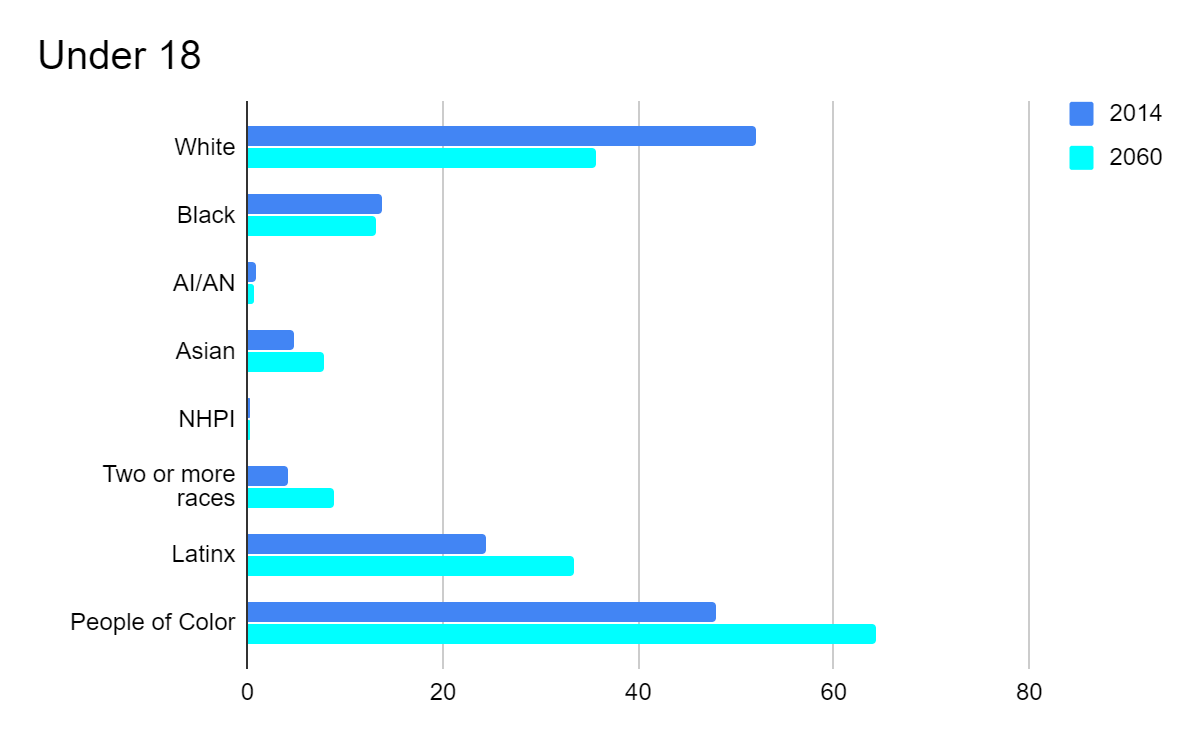
Culture & Technology
Technology allows us to eliminate communication boundaries and interact with each other on a global scale. Globalization is typically associated with the creation of the world-spanning free market and global reach of capitalist systems resulting from technological advances (Back, Bennett, Edles, Gibson, Inglis, Jacobs & Woodward, 2012). However, globalization has the unintended consequences of connecting every person in the world to each other. In this era, everyone’s life is connected to everyone else’s life in obvious and hidden ways (Albrow, 1996). We are moving beyond local, state, and national identities to broader identities developing from our global interactions forming transnational communities.
With the world in flux from globalization and technological advances, people are developing multiple identities apparent in their local and global linkages. Cultural identity is becoming increasingly contextual in the postmodern world where people transform and adapt depending on time and place (Kottak & Kozaitis, 2012). Approximately two-thirds of U.S. adults are online connecting with others, working, studying, or learning (Griswold, 2013). The increasing use of the Internet makes virtual worlds and cybersocial interactions powerful in constructing new social realities. Having a networked society allows anyone to be a cultural creator and develop an audience by sharing their thoughts, ideas, and work online. Amateurs are now cultural creators and have the ability to control dissemination of their creations (Griswold 2013). Such as the use of social media and mass protests in outrage against the police killing of George Floyd in 2020, the instant responses and connections to others beyond time and place immediately impact our lives, and we have the technology to react quickly with our thoughts and actions.

Technology can create positive change leading to advances in medical technology, agricultural technology, or educational technology impacting childbirth, respective impacting climate change, and children's learning. Drawbacks include the increasing gap between the technological haves and have-nots––sometimes called the digital divide––which occurs both locally and globally. Further, there are added security risks: the loss of privacy, the risk of total system failure, and the added vulnerability created by technological dependence. These threats impacted the 2016 U.S. election and are bound to further impact future elections.
Natural Environment
Environmental changes are one of the many sources of social change. Our worst environmental problems are the result of human activity. Climate change is the term now used to refer to long-term shifts in temperatures due to human activity and, in particular, the release of greenhouse gases into the environment. One effect of climate change is more extreme weather. We see the clearest evidence of this impact when a major hurricane, an earthquake, or another natural disaster strikes. In January 2010, for example, a devastating earthquake struck Haiti and killed more than 250,000 people, or about 2.5 percent of that nation’s population. The effects of these natural disasters on the economy and society of Haiti will certainly also be felt for many years to come. Droughts, floods, hurricanes, and fires are some of the expected impacts of climate change in the next century. These natural disasters, as with the prevalence of environmental racism, environmental injustice that occurs within a racialized context both in practice and policy, will likely have a more dramatic impact on communities of color and poor populations, as we saw with the effects of Hurricane Katrina in 2005.
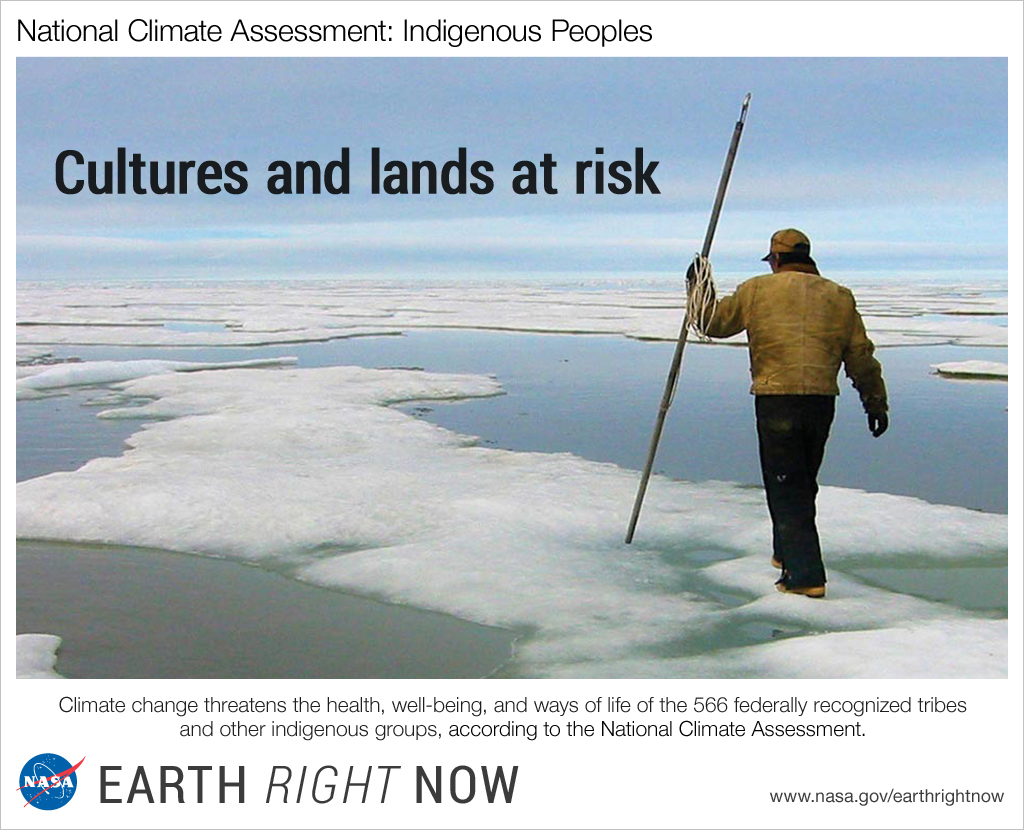
Social Institutions
Each change in a single social institution leads to changes in all social institutions including family, education, politics, economics, religion, mass media, health care, and the criminal justice system.
For example, the industrialization of society meant that there was no longer a need for large families to produce enough manual labor to run a farm. Further, new job opportunities were in close proximity to urban centers where living space was at a premium. The result is that the average family size shrunk significantly, and men were separated from their families for longer time periods.
Our contemporary society reflects other changes in our social institutions. Defined by the increasing mass incarceration rates in the U.S. since the 1980s, the cradle-to-prison pipeline has most severely impacted African American families. As many urban jobs were outsourced to less industrialized countries in the 1980s, the rise of the illicit drug market provided economic "opportunities" for those left behind in these urban communities. Harsh drug laws sent many non-violent drug offenders behind bars for decades if not lifetimes. The lyrics of musical artists, such as Tupac, at the turn of the last century conveyed the struggles in urban communities surrounding drugs, poverty, and the police. Countless children were raised in single parent homes as Tupac's song Dear Mama depicts. (Though 1/4 of all families in the U.S. today are single-parent households, most African American children are currently raised by single parents.) Being raised in a low-income, single-parent family has a high potential to impact quality family time, sometimes resulting in lesser educational outcomes.
Connecting dysfunctional social institutions, Shirley Better presented the term web of institutional racism, further discussed in Chapter 6.5, to explain the interrelated impact of substandard housing, poor schooling opportunities, lack of job opportunities, and inadequate health care.
Social Movements
Voting Rights, A Social Movement
On March 7, 1965, African American leaders, including Dr. Martin Luther King, jr. and the late Congressman John Lewis, led a march of 600 people in an attempt to walk the 54 miles (87 km) from Selma to the state capital in Montgomery. Only six blocks into the march, however, state troopers and local law enforcement attacked the peaceful demonstrators with billy clubs, tear gas, rubber tubes wrapped in barbed wire, and bull whips. They drove the marchers back to Selma. The national broadcast showing footage of lawmen attacking unresisting marchers seeking the right to vote provoked a national response. Eight days after the first march, Lyndon Johnson delivered a televised address to garner support for the voting rights bill he had sent to Congress. In it he stated:
But even if we pass this bill, the battle will not be over. What happened in Selma is part of a far larger movement which reaches into every section and state of America. It is the effort of American Negroes to secure for themselves the full blessings of American life. Their cause must be our cause too. Because it is not just Negroes, but really it is all of us, who must overcome the crippling legacy of bigotry and injustice. And we shall overcome.
Johnson signed the Voting Rights Act of 1965 on August 6. The 1965 Act suspended poll taxes, literacy tests, and other subjective voter tests. It authorized federal supervision of voter registration in states and individual voting districts where such tests were being used. The act had an immediate and positive impact for African Americans. Within months of its passage, 250,000 new Black voters had been registered. Within four years, voter registration in the South had more than doubled. Further discussion of the Voting Rights Act of 1965 is discussed in Chapter 7.4.
Understanding how to organize a social movement to pursue social change is one of the areas studied by sociologists. The insights gained from these studies can provide movement members the tools they need to succeed.
This section is licensed by CC BY-SA. Attribution: Sociology (Boundless) (CC BY-SA 4.0)
A social movement may be defined as an organized effort by a large number of people to bring about or impede social change. Defined in this way, social movements might sound similar to special-interest groups, and they do have some things in common. But a major difference between social movements and special-interest groups lies in the nature of their actions. Special-interest groups normally work within the system via conventional political activities such as lobbying and election campaigning. In contrast, social movements often work outside the system by engaging in various kinds of protest, including demonstrations, picket lines, sit-ins, and sometimes outright violence. These rallies, demonstrations, sit-ins, and silent vigils are often difficult to ignore. With the aid of news media coverage, these events often throw much attention on the problem or grievance at the center of the protest and bring pressure to bear on the government agencies, corporations, dominant groups or people of color, or other targets of the protest.
There are many examples of profound changes brought about by social movements throughout U.S. history (Amenta, Caren, Chiarello & Sue, 2010; Meyer, 2007; Piven, 2006). The abolitionist movement called attention to the evils of slavery and increased public abhorrence for that “peculiar institution” of slavery. The women's suffrage movement eventually won women the right to vote with the ratification of the 19th Amendment in 1920, though this right was primarily experienced only by Euro American women. As discussed further in Chapter 7.5, the Civil Rights Movement resulted in the Voting Rights Act of 1965 and the Civil Rights Act of 1964, policies which aimed to promote equality and non-discrimination. In recent years, the following social movements have surfaced, with particular attention to the topics of race, social class, and gender: immigration rights, Occupy Movement, No Dakota Access Pipeline defending Native American land and sovereignty, the #metoo movement against sexual harassment, the gay rights movement, poor people's campaign, white nationalism, and the Black Lives Matter movement.
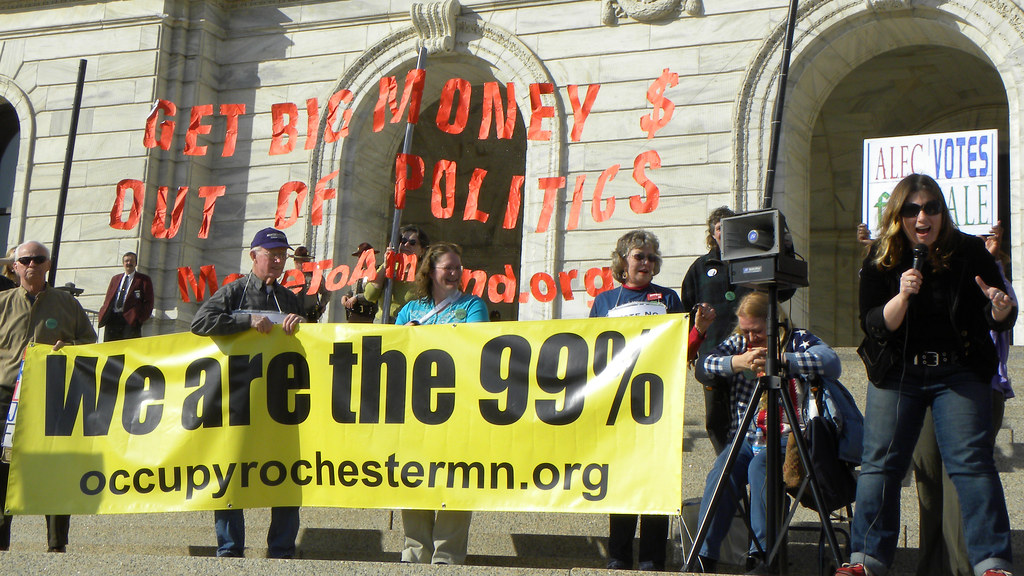
Social movements may have biographical consequences. Several studies find that people who take part in social movements during their formative years (teens and early 20s) are often transformed by their participation. Their political views change or are at least reinforced, and they are more likely to continue to be involved in political activity and to enter social change occupations. In this manner, writes one scholar, “people who have been involved in social movement activities, even at a lower level of commitment, carry the consequences of that involvement throughout their life” (Giugni, 2008, p. 1590).
Types of Social Movements
One way to consider social movements is to categorize social movements based on what they want to change and how much change they want (Aberle, 1966). (More discussion on types of social movements is provided in Chapter 11.1). Reform movements seek to change something specific about the social structure, including political, economic, or social systems. Historical examples include the abolitionist movement preceding the Civil War, the woman suffrage movement that followed the Civil War, the Southern civil rights movement, the gay rights movement, and the environmental movement. Contemporary examples of reform movements include the DREAMers movement for immigration reform and the Black Lives Matter movement. Revolutionary movements extend one large step further than a reform movement in seeking to overthrow the existing government and to bring about a new one and even a new way of life. These revolutionary or political movements seek to completely change every aspect of society. The United States, French, Mexican and other national revolutions fall under this category. Reactionary movements seek to prevent or undo change to the social structure. The Ku Klux Klan (KKK) and the Minutemen militia represent examples of reactionary movements. Both of these movements reflected white supremacy, while the KKK projected anti-Black, anti-Jewish and anti-immigrant attitudes, and the latter reflected nativism, the policy and practice of promoting the interests of "native" inhabitants against those of immigrants. In their attempt to return the institutions and values of the past by doing away with existing ones, conservative reactionary movements seek to uphold the values and institutions of society and generally resist attempts to alter them. In contemporary society, white nationalism represents a reactionary movement which grew as a result of the "birther movement," trying to sway public opinion that President Obama was not born in the U.S. and expanded during President's Trump era with the rise of hate groups and hate crimes against Asian American Pacific Islanders, immigrants, Mexicans, and African Americans. Such conservative reactionary movements may elicit polarizing attitudes and behaviors reflecting a different type of social movement.
Thinking Sociologically
Which source of social change has most positively or negatively impacted race and ethnic relations in history? And, which source of social change is most positively or negatively impacting race and ethnic relations today? Lastly, what social change do you predict will most positively or negatively impact race and ethnic relations through the mid 21st century?
Resistance
According to Jocelyn Hollander and Rachel Einwohner (2004), sociologists define resistance in terms of action and opposition. Action connects to active behavior in opposition to injustice perpetuated by dominant culture. As individuals, we have personal agency, but we are limited in our ability to make the societal changes we may like to make. As social scientists Kenneth Kammeyer, George Ritzer and Norman Yetman (1996) explain, "there are massive social forces that make change difficult; these social forces include government, large and powerful organizations, and prevailing norms, values and attitudes." As individuals protesting against these official forces and social norms, we have minimal power. Yet, Kammeyer, Ritzer and Yetman (1996) remind us that if we combine forces with others who share our convictions, if we organize ourselves and our groups, and if we map out a course of actions, we may be able to bring about numerous and significant changes in the prevailing social order. Through participation in a social movement, we can break through the "social constraints that overwhelm us as individuals" (Kammeyer et al., 1996).
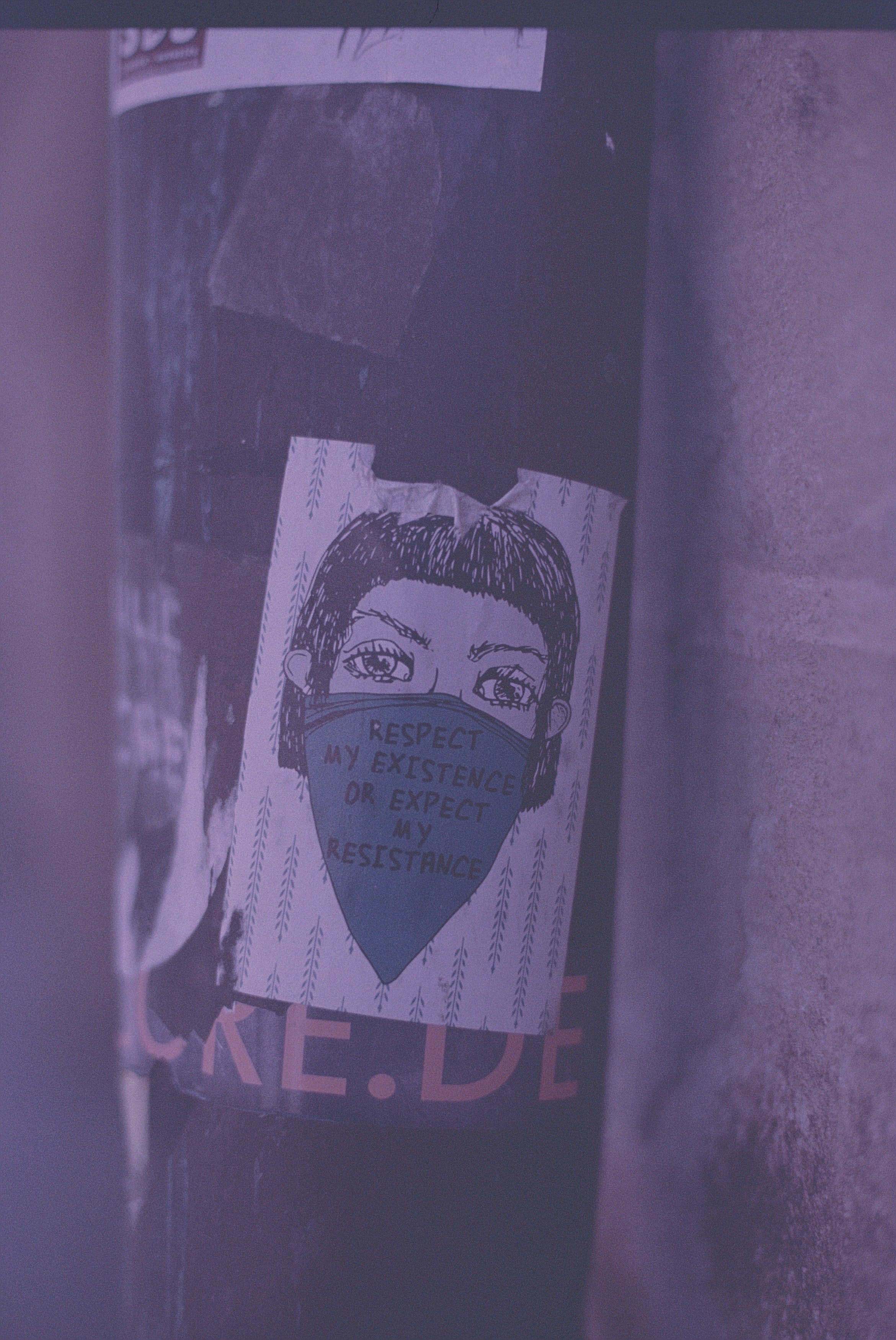
Throughout U.S. history, many individuals, groups and social movements have strived to resist against dominant forces of oppression, colonialism, and blocked life chances. Tecumseh/Shooting Star/Panther Crossing the Sky (1768-1813), a leader of the Shawnee Nation known as "the Prophet," resisted against the Euro-American land conquest and military might. Tecumseh envisioned a pan-Indian, Red Nation united against Euro-American encroachment on the native land. In Tecumseh's words, "a single twig breaks easily, but the bundle of twigs is strong. Someday I will embrace our brother tribes and draw them into a bundle and together we will win our country back from the whites." While his pan-Indian movement was not successful in drawing together a multitude of American Indian nation leaders and the U.S. military might defeated this movement, this history reminds us of the foundation of resistance in this country.
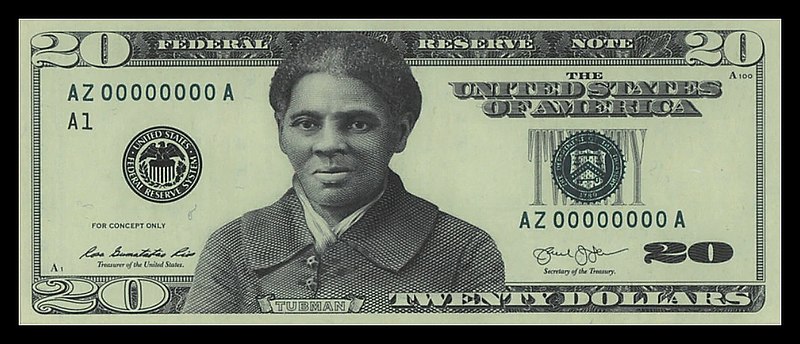
Abolitionist Harriet Tubman (1820-1913) conducted numerous voyages to free hundreds of enslaved Africans from the southern U.S. to the north, including the U.S. and Canada. Working as a "conductor" in the Underground Railroad, Tubman and others resisted the dehumanization of the peculiar institution of slavery in pursuit of freedom. With their activist roots in the abolition movement, many early suffragists such as Angelina and Sarah Grimke as well as Sojourner Truth sought to gain the right to vote for all women, despite the fact that many suffragists were split on the issue of including the vote for African American women.
In the 1960s, resistance movements were led by Reverend Dr. Martin Luther King, jr (1925-1968) with the mainstream civil rights movement as well as by Black Nationalist/Black Power movement with Malcolm X (1925-1965) in the forefront. Both of these movements challenged racial, inhumane treatment in the U.S., and both of these leaders extended their gaze to the global scene, recognizing U.S. militarism abroad and reflecting upon colonial attitudes in the southern hemisphere. While Malcolm X recognized the independence movements in Africa as resistance against European colonialism, Dr. King was particularly critical of the U.S. involvement in the "American War" in Vietnam. Still, competing white supremacist organizations, including police commissioners, politicians, and the Ku Klux Klan pushed back against these resistance movements. Back in the U.S., the Chicano Moratorium (1970) called attention to the lost lives of enlisted Chicanos and the disenfranchisement of Chicano communities in U.S. cities, particularly Los Angeles and San Diego and thus questioned the involvement of Chicanos in fighting a war abroad when they were not experiencing democracy at home. In the same time period, the American Indian Movement kicked off in Minneapolis in 1969 to stand against white control of schools, economic institutions and Native American religious practices.
Video \(\PageIndex{8}\): Andra Day - "Rise Up" (Lyrics). (Close-captioning and other YouTube settings will appear once the video starts.) (Fair Use; 7clouds via YouTube)
In the first few decades of the 21st century, many examples of collective efforts at challenging institutional power can be understood. Rise Up by Andra Day (click the video above) has been tied to the Black Lives Matter movement. The #metoomovement called attention to sexual harassment; one of the key victories of this resistance movement was the sentencing of media mogul, Harvey Weinstein, convicted of 2 counts of sexual harassment and rape. Pro-immigration rallies and marches in U.S. cities in 2006 expressed hope for undocumented peoples, with eyes on the prize of comprehensive immigration reform which has yet to be realized. Yet, DACA, Deferred Action for Childhood Arrivals, an executive order passed by President Obama in 2012 reflected one win for this movement - against a backdrop of anti-immigrant sentiment which fueled Trump's Presidential bid. In 2016, in Standing Rock, North Dakota, Lakota leaders such as Madonna Thunderhawk organized resistance against the capitalist venture, the Dakota Access Pipeline, uniting hundreds of Indigenous and non-Indigenous peoples against the corporate pipeline through sacred land, with the potential to pollute sacred water.
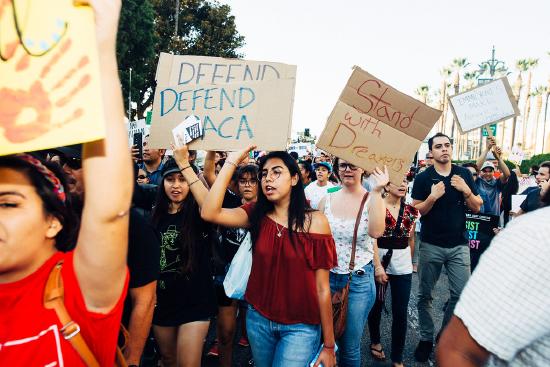
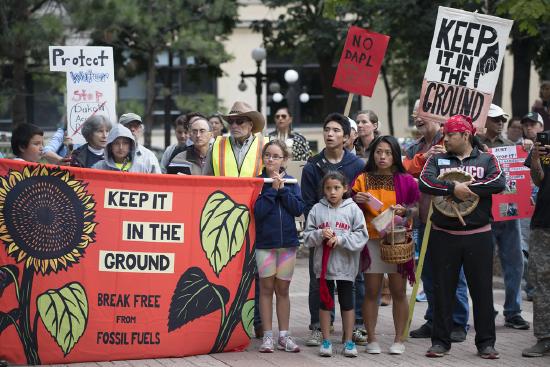
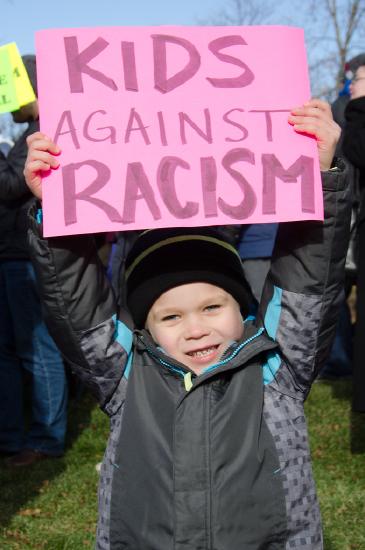
As stated in the opening of this chapter, during the COVID-19 pandemic, the mass protests that erupted following the police killing of George Floyd sparked a national and international movement against police brutality and systemic racism. Amidst the increase in hate crimes reported in Asian American Pacific Islander (AAPI) communities during the COVID-19 crisis, AAPI groups held protests against these acts of violence and hate speech such as "Chinese Virus" and "Kung Flu" and "go back home."
The U.S. has a rich history of resistance against oppression and white supremacy. How will the U.S. fare moving into the middle part of the 21st century?
In the words of George Takei (the famous voice from Star Trek and survivor of the Japanese Internment Campus during WWII) published in The Advocate (2016),
In today’s political environment, we find ourselves again outsiders, forming a core of those opposed to the powers in Washington and in many of our state capitals… It is axiomatic that little worth fighting for has ever come without a fight… We truly have grown stronger together, and with each new assault upon our dignity and humanity, we will grow stronger still. So welcome to the resistance. It’s where the next heroes of our movement will emerge. Be ready. Be vigilant. Be strong.
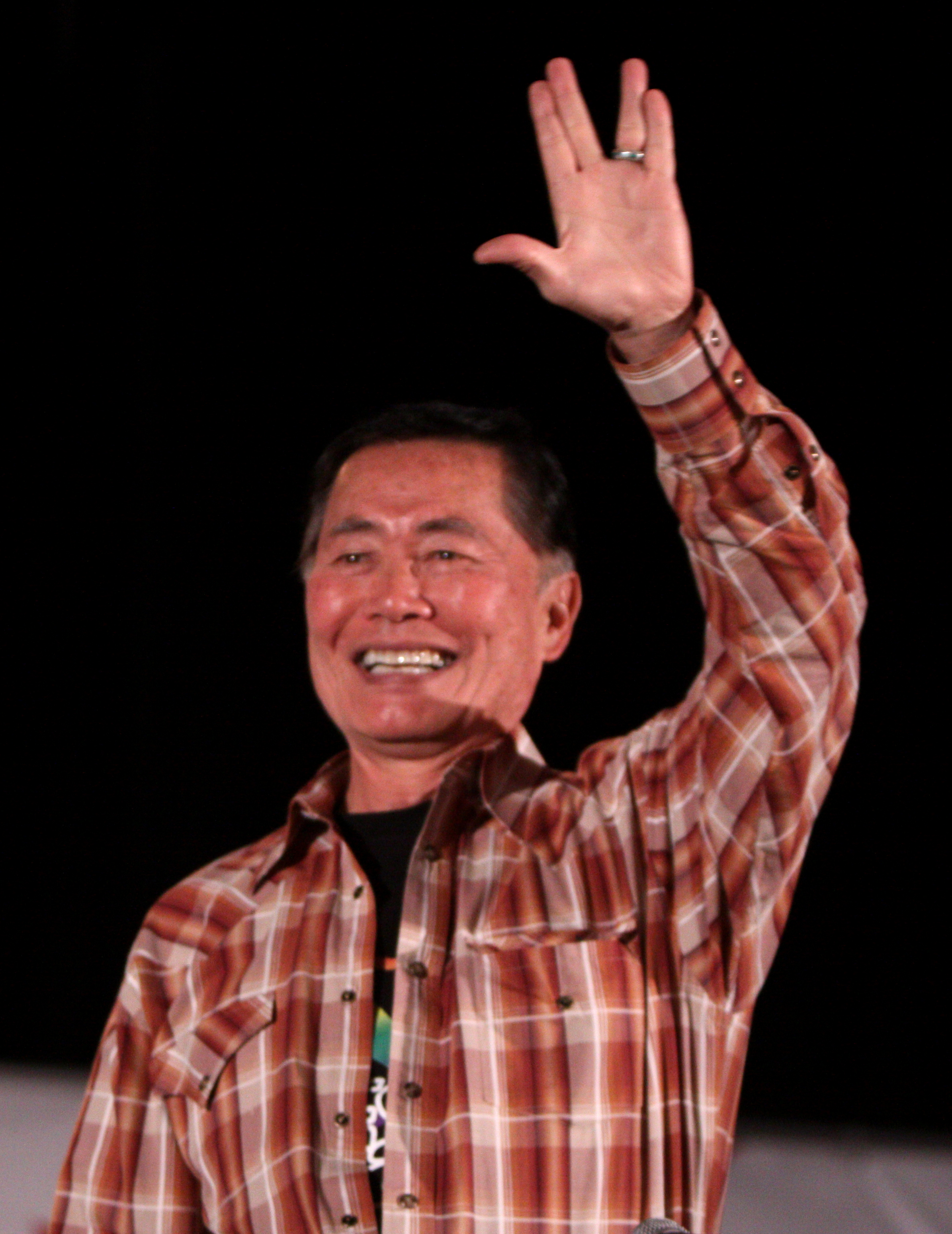
Key Takeaways
- Sources of social change that may impact race and ethnic relations include: modernization and urbanization, population growth and composition, culture and technology, natural environment, social institutions and social movements.
- Resistance and resistance social movements throughout history illustrate how individuals and groups have responded against dominant forces of oppression, colonialism, and blocked life chances.
Contributors and Attributions
Content on this page has multiple licenses. Everything is CC BY-NC-SA other than Voting Rights, A Social Movement which is CC BY-SA.
- Hund, Janét. (Long Beach City College)
- Rodriguez, Lisette. (Long Beach City College)
- Sociology (Barkan) (CC BY-NC-SA 4.0)
- Sociology (Boundless) (CC BY-SA 4.0) (Contributed to Voting Rights, A Social Movement)
- Introduction to Sociology 2e (OpenStax) (CC BY 4.0)
Works Cited
- Aberle, D. (1966). The Peyote Religion among the Navaho. Chicago, IL: Aldine.
- Albrow, M. (1996). The Global Age. Cambridge, UK: Polity Press.
- Amenta, E., Caren, N., Chiarello, E. & Sue, Y. (2010). The political consequences of social movements. Annual Review of Sociology, 36, 287–307.
- Back, L., Bennett, A., Edles, L.D., Gibson, M., Inglis, D., Jacobs, R. & Woodward, I. (2012). Cultural Sociology. Hoboken, NJ: Wiley-Blackwell.
- Better, S. (2007). Institutional Racism: A Primer on Theory and Strategies for Change. 2nd Ed. Lanham, MD: Rowman and Littlefield Publishers.
- Cilluffo, A. & Cohn, D. (2019, April 11). 6 demographic trends shaping the U.S. and the world in 2019. Pew Research Center.
- Colby, S.L. & Ortman, J.M. (2015). Projections of the size and composition of the u.s. population: 2014 to 2060. U.S. Census.
- Giugni, M. (2008). Political, biographical, and cultural consequences of social movements. Sociology Compass, 2, 1582–1600.
- Griswold, W. (2013). Cultures and Societies in a Changing World. 4th ed. Thousand Oaks, CA: Sage Publications, Inc.
- Hollander, J.A. & Einwohner, R. (2004). Conceptualizing resistance. Sociological Forum, Vol. 19, Issue 4.
- Kammeyer, K.C.W., Ritzer, G., Yetman, N.R. (1996). Sociology: Experiencing Changing Societies, Economy Version Subsequent Edition. Boston, MA: Allyn & Bacon.
- Meyer, D.S. (2007). The Politics of Protest: Social Movements in America. New York, NY: Oxford University Press.
- Piven, F.F. (2006). Challenging Authority: How Ordinary People Change America. Lanham, MD: Rowman & Littlefield.
- Takei, G. (2016, December 21). George Takei: "Welcome to the resistance." The Advocate.

